tl;dr 🙂
Some history
When I was in year nine at high school, I heard a radio programme on the ABC which deeply affected me. From the BBC Horizon series of science and technology programmes, it was called “The Hunting of the Quark” and was released in May 1974. The programme provided an overview of the current state of knowledge and research into particle physics. The description of the science and scale of engineering being undertaken at CERN in Europe in the pursuit of the elusive fundamental particles of nature filled me with a sense of awe and wonder that has never left me.
Fast forward some forty five years and I am still awe struck at the scale of the work undertaken at CERN and I am so happy to have been able to visit the largest science laboratory on the planet – even if only as a humble visitor.
You can learn more about CERN here.
What’s in a name?
At an intergovernmental meeting of UNESCO in Paris in December 1951, the first resolution concerning the establishment of a European Council for Nuclear Research (in French, Conseil Européen pour la Recherche Nucléaire) was adopted. CERN is now generally referred to as the European Laboratory for Particle Physics – but the acronym has long since stuck.
Our visit
CERN’s visitor centre is only a short tram ride north-west of the centre of Geneva and about 200 metres from the French border. Much of CERN’s equipment is distributed between Switzerland and France. The Super Proton Synchrotron (SPS) is the second-largest machine in CERN’s accelerator complex with a circumference of 7 km. It is perfectly bisected by the Swiss-French border running as a diagonal across the central axis of the machine causing the particles in the two counter-rotating beams travelling at near the speed of light (300,000,000 m/s) to cross the border about 100,000 times every second. There are no hard borders at CERN for sub-atomic particles!
2004 was the 50th anniversary of CERN and to mark the occasion, the Universe of Particles permanent exhibition was opened along with a striking piece of art in the form of a metal spiral (perhaps depicting the path of a decaying particle). In the picture below the large brown dome contains the Universe of Particles – which unfortunately was closed for maintenance for the exact duration of our stay in Geneva. 🙁
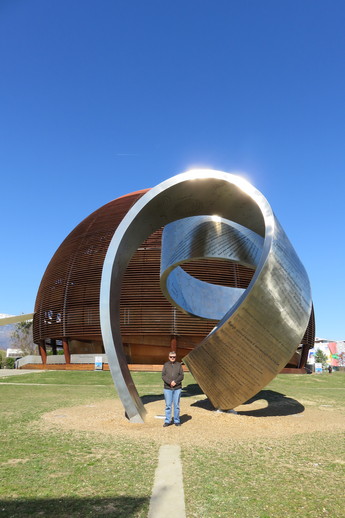
On one side of the metal strip is a list of famous scientists, mathematicians and “natural philosophers” along with a brief description of their principal contribution to knowledge. On the other side is a series of equations, drawings and symbols starting with Euclidean geometry and finishing with the Standard Model Lagrangian which represents our current best understanding of how the universe, and all it contains, functions.
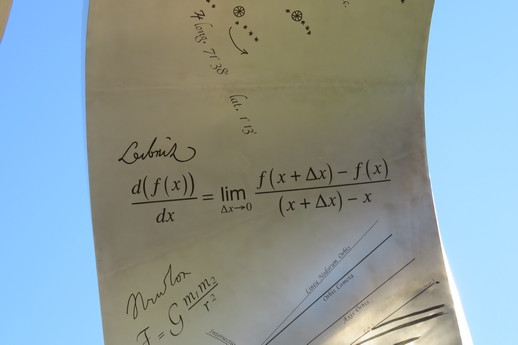
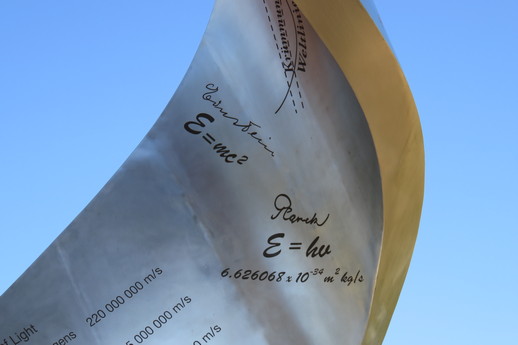
In the basement of the visitor centre is another permanent exhibition that can be viewed without having to be on a guided tour. Called Microcosm, it provides an extensive and interactive presentation of the background into what CERN is looking for, how it goes about it and the machines it has designed and constructed to do it.
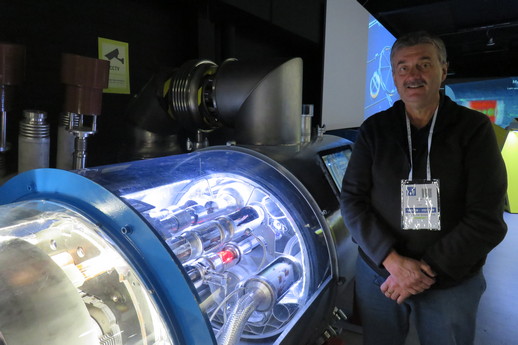
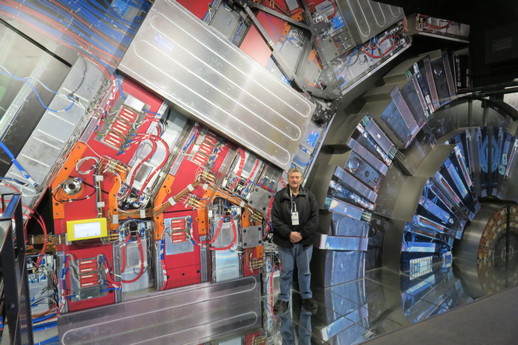
Associated with Microcosm, there is an outside garden containing decommissioned hardware. The image below shows one of the acceleration cavities from the Large Electron-Positron (LEP) collider.
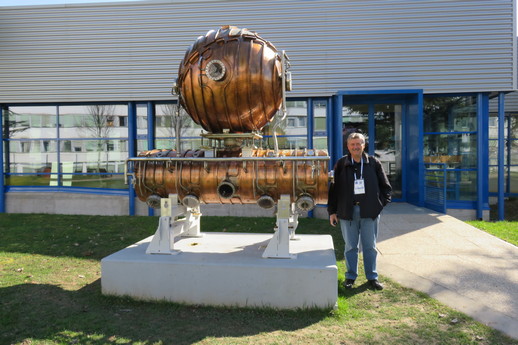
With its 27 km circumference, the LEP collider was – and still is – the largest electron-positron accelerator ever built. The excavation of the LEP tunnel was Europe’s largest civil engineering project prior to the Channel Tunnel. Three tunnel-boring machines started excavating the tunnel in February 1985 and the ring was completed three years later.
LEP was commissioned in July 1989 and the first beam circulated in the collider on 14 July. In 1995 LEP was upgraded for a second operation phase before it was finally closed down on 2 November 2000 to make way for the construction of the Large Hadron Collider in the same tunnel.
Large Hadron Collider (LHC)
Commissioned on 10 September 2008, the LHC exists to provide high energy particles for experiments, located at specific locations on the circumference of the LHC ring. ATLAS and CMS are the largest experiments.
-
-
- ATLAS: A Toroidal LHC Apparatus
- CMS: Compact Muon Solenoid
- MoEDAL: Monopole and Exotics Detector At the LHC
- ALICE: A Large Ion Collider Experiment
- LHCb: LHC-beauty
- LHCf: LHC-forward
-
ATLAS
Beams of particles from the LHC collide at the centre of the ATLAS detector making collision debris in the form of new particles, which fly out from the collision point in all directions. Six different detecting subsystems arranged in layers around the collision point, record the paths, momentum, and energy of the particles, allowing them to be individually identified. A huge magnet system bends the paths of charged particles so that their momenta can be measured.
The interactions in the ATLAS detectors create an enormous flow of data. To digest the data, ATLAS uses an advanced “trigger” system to tell the detector which events to record and which to ignore. Complex data-acquisition and computing systems are then used to analyse the collision events recorded. At 46 m long, 25 m high and 25 m wide, the 7000-tonne ATLAS detector is the largest volume particle detector ever constructed. It sits in a cavern 100 m below ground near the main CERN site. The following image shows the control room and maintenance buildings associated with the ATLAS experiment.
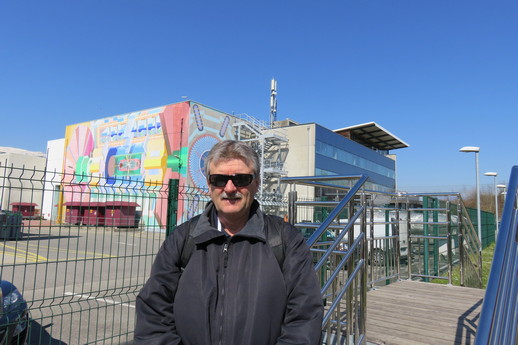
The guided tour
Each of our guided tours lasted two hours, in which we were able to visit two sites within walking distance of the visitors centre; CERN’s first particle accelerator, the Synchrocyclotron and the ATLAS experiment buildings.
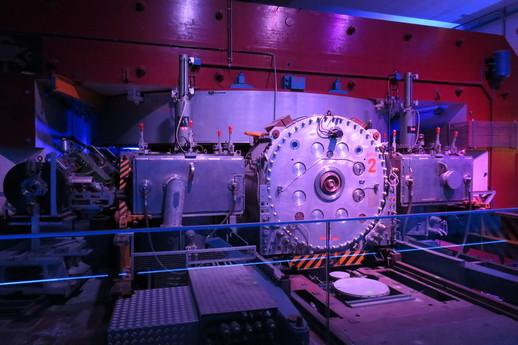
The Synchrocyclotron (SC) built in 1957, was CERN’s first accelerator. It provided beams for CERN’s first experiments in particle and nuclear physics. In 1964, this machine started to concentrate on nuclear physics alone, leaving particle physics to the newer and much more powerful Proton Synchrotron (PS).
The SC became a remarkably long-lived machine. In 1967, it started supplying beams for a dedicated unstable-ion facility called ISOLDE, which carries out research ranging from pure nuclear physics to astrophysics and medical physics. In 1990, ISOLDE was transferred to a different accelerator, and the SC was closed down after 33 years of service. The building housing the SC has been transformed using clever audio-visual presentations showing the history of CERN and the basic operation of the SC with animated images superimposed over the machine.
On our first tour (Wednesday), we were fortunate to have a very enthusiastic theoretical physicist from China as our guide. As one of more than 10,000 scientists and technicians who work at CERN, he was very happy to patiently answer the most inane of questions and spoke with great excitement about the possibility of a new accelerator with a proposed circumference of 100 km. [Increasing the size of the accelerator ring reduces the energy losses involved in making the beams run around the ring – leaving more available when the particles are subsequently smashed together.]
On our second tour (Thursday), our guide, of Russian heritage, was less informative and somewhat dismissive about the likelihood of the 100 km accelerator ever being constructed.
The Higgs boson
On 4 July 2012, Daniel and I were sitting in front of the computer in my study watching a live internet streaming presentation from CERN during which both the ATLAS and CMS experimental teams announced they had each observed a new particle in the mass region around 125 GeV (Giga-electron volts; 125,000,000,000 eV; a measure of mass used in particle physics). This particle was consistent with that of the Higgs boson, as proposed within the Standard Model based on the work of three therotical physisists during the 1970s. Robert Brout, François Englert and Peter Higgs proposed a mechanism that is now called the Brout-Englert-Higgs mechanism and which predicts particles having properties observed during the ATLAS and CMS experiments.
On 8 October 2013, the Nobel prize in physics was awarded jointly to François Englert and Peter Higgs * “for the theoretical discovery of a mechanism that contributes to our understanding of the origin of mass of subatomic particles, and which recently was confirmed through the discovery of the predicted fundamental particle, by the ATLAS and CMS experiments at CERN’s Large Hadron Collider”. *Robert Brout passed away on 3 May 2011.
CERN and the World Wide Web
The first website at CERN – and in the world – was dedicated to the World Wide Web project itself and was hosted on a computer belonging to Tim Berners-Lee, a British computer scientist working at CERN. Developed as a collaborative tool to rapidly disseminate information within CERN, the underlying software and communication protocols that enable the operation of the WWW was subsequently given away to the public domain. The fact you can read this blog on a browser on your computer or smartphone is due to the brilliance of Berners-Lee and his fellow CERN scientists layered on top of the underlying Internet network of distributed computing resources.
Saying goodbye to CERN
I’m pleased to say that no leptons, fermions, bosons, quarks or any other, as yet undiscovered, elemental particles were harmed during our visit to CERN as the LHC is shutdown for a two year period while its components are enhanced to produce beams with an energy of 7 TeV (Tera-electron volts; 7,000,000,000,000 eV). The LHC is scheduled to be back on line sometime during 2020.
With so much fascinating stuff to see and information to absorb it was hard to finally climb aboard the tram and head back into Geneva on Thursday afternoon.
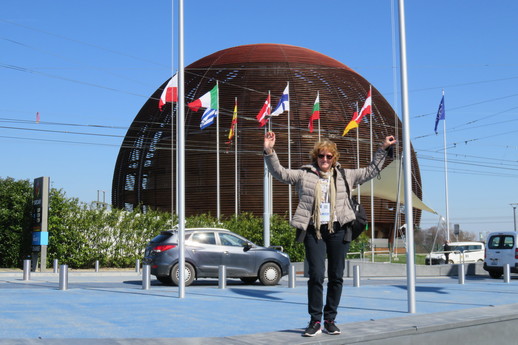
I’d like to say a special thank you to my dearest Christine for engaging patiently with me for two whole days at CERN. She gets the quark charm award; I expect I’m in line for the quark strange award, and you, dear reader, get the quark top award for making it all the way to the end of this post. 🙂
Well done Chris. Is there a cemetery there ? Maybe Greg May like to be buried there?
Hi Mary – thanks for your thoughtful contribution. Do you think Chris should make such an enquiry before or after we leave Europe?
Man o man, I didn’t even read all of this one. My eyes glazed over 🤦🏻♀️ Chris looks sooooo happy it’s all over!
Okay – I know the text could be improved for readability but this isn’t a peer reviewed journal and I’m not a trained communications professional, so please cut me some slack. Oh, and I did warn you up front – tl;dr 🙂
So what does tl:dr mean?
My, what fun you have had in CERN land. I applaud Chris’s staying power! I read it all, Greg, and understood every few words but I certainly caught the enthusiasm – so, I am glad you got to enjoy yourself so much.
Travel safely.
Hi Dianne, thanks for your supportive feedback.
tl;dr is urban slang shorthand for “too long; didn’t read”.
I’ve waited for a long time to visit CERN and really wanted to make the most of the opportunity.
BTW – this published version is somewhat shorter than its previous drafts. 🙂
I am wondering just how much you left out of your original version! This was a saga anyway!
There were ten draft revisions of the CERN blog post before I published the final version.
tl;dr